Time is of the essence! I encourage you to venture out soon into the woodland areas of our parks to enjoy the fragile flowers known as spring ephemerals. They bloom before the forests turn fully green!
These fragile, woodland wildflowers begin their brief above-ground lives in the bright light slipping between the limbs of the bare canopy above them. After the ephemeral’s leaves emerge , buds and blooms follow quickly. Early pollinators, like our small native bees, dart among them, sipping nectar, leaving with a bit of pollen. The pollinated plants then hurriedly produce and disperse their seed – many with the aid of ants, as I’ll explain below. The leaves of some remain behind for several weeks as the canopy leafs out and the light dims. Others quickly fade away completely, continuing their lives beneath the forest floor in rhizomes, roots and bulbs until next spring.
I’ve been finding these early risers in several parks: Bear Creek Nature Park, Cranberry Lake Park, the woods at the Wet Prairie, Charles Ilsley Park, Stony Creek Ravine Nature Park, Lost Lake Nature Park and Fox Nature Preserve. And I’m sure they’ve emerged at other township parks, too. But warmer weather brings their short but lovely sojourn above ground to a close. So, if you’re able, slip on your cool weather clothes and head out to appreciate these hardy little wonders on a sunny day before they disappear.
Meet the Ephemerals!
Spring Beauty (Claytonia virginica)

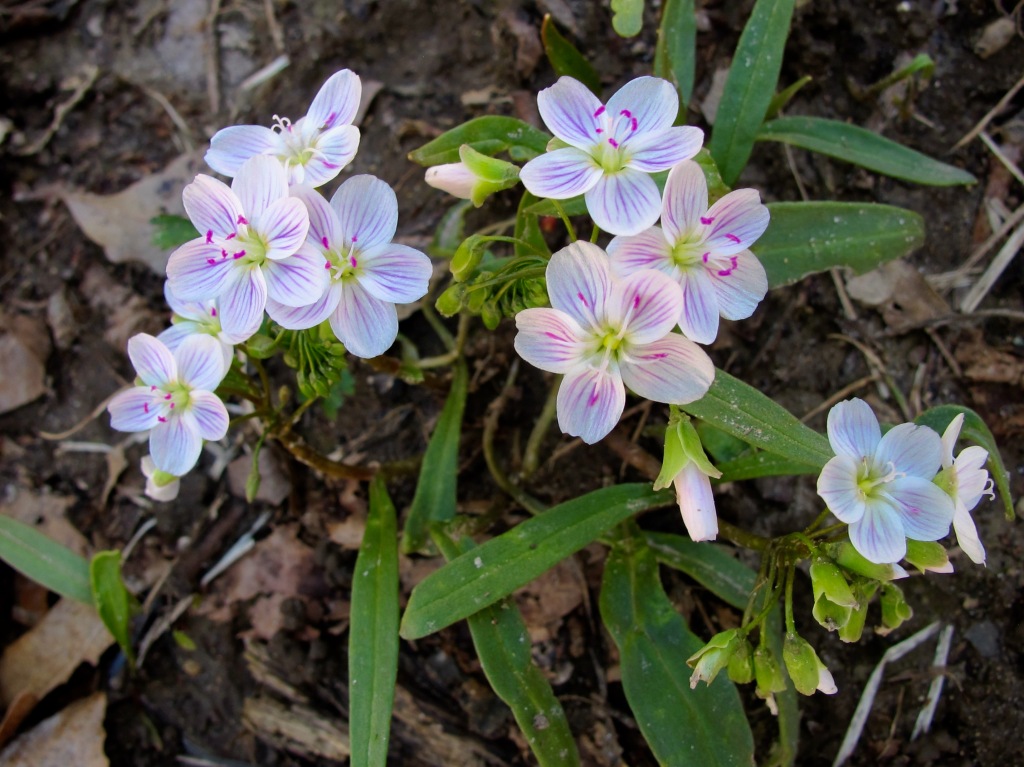

Spring Beauty’s leaves emerge in pairs, often at the foot of large trees. The dainty pink and white blossoms come shortly thereafter. These tiny flowers are life-savers for twenty-seven species of native bees, like the little Green Sweat Bee (above right), which benefit from the plentiful nectar of Spring Beauties on chilly spring days. Their seeds come attached to elaiosomes , bundles of fat which ants evidently find delectable. They abscond with the seeds, taking them to their underground nests. After eating the elaiosome, they discard the seed in their nest debris where it gets fertilized and germinates the following year. Cool means of dispersal, eh? As you’ll see, the seeds of many ephemerals are “planted” by ants!
Bloodroot (Sanguinaria canadensis)
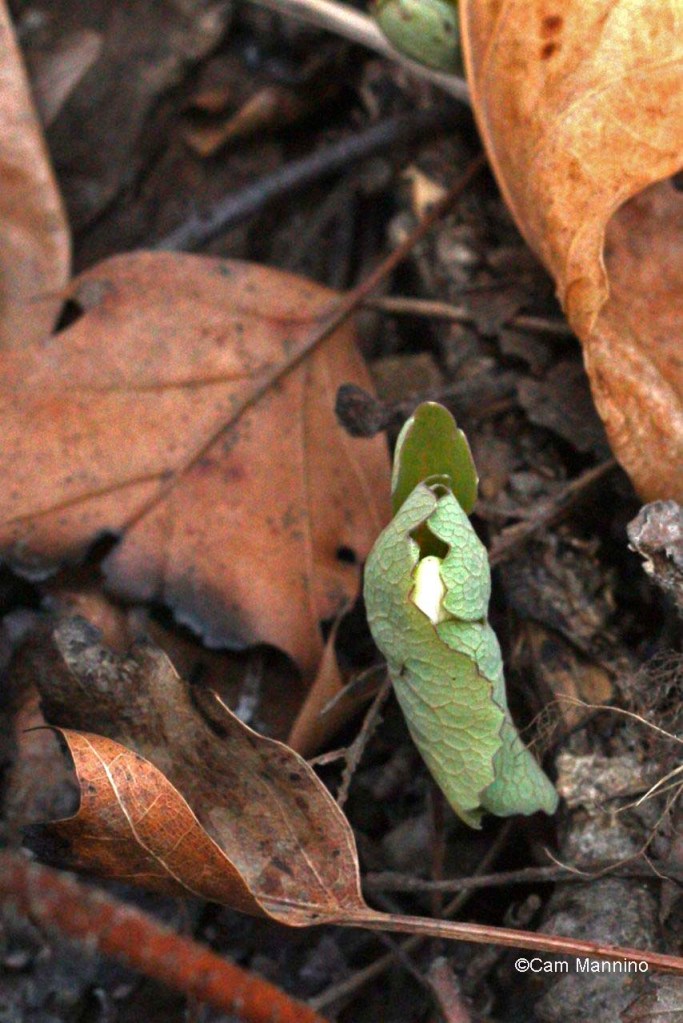
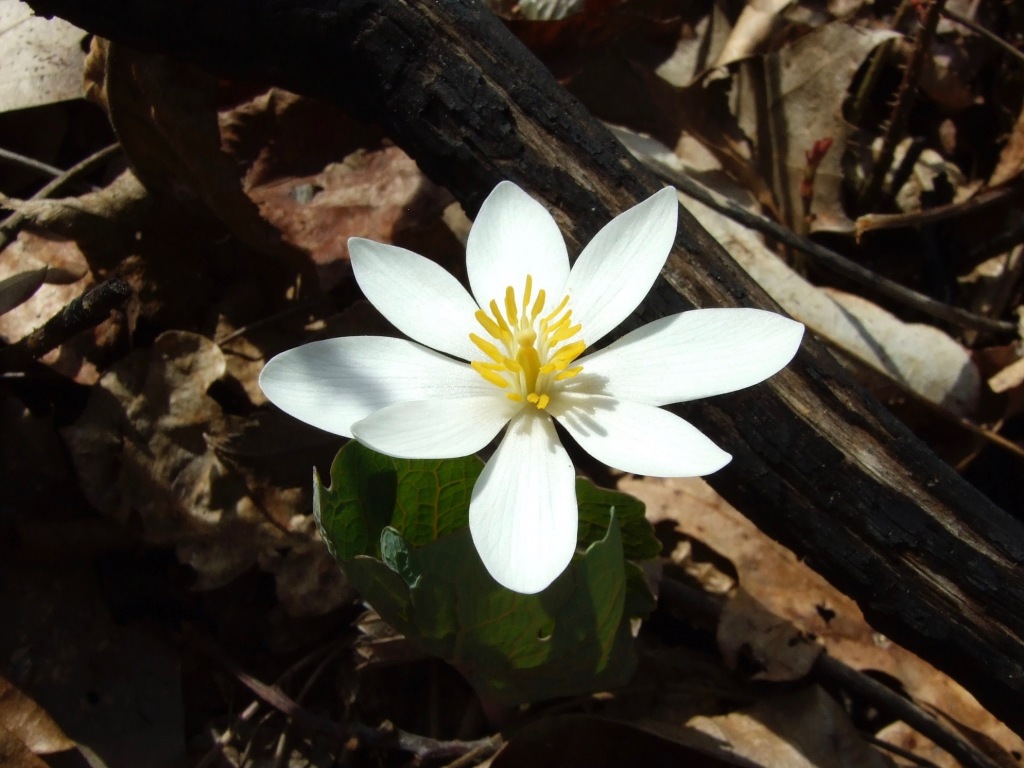

Bloodroot starts its season in the sun by sending up a delicate stem with a flower bud, wrapped in a leaf. Once the bud unfolds into a sunny white flower, its bright yellow stamens attract bees for pollen, but it disappoints most pollinators because for some reason, it produces no nectar! After the petals fall (they are easily knocked off by a hard rain!), the leaf unfurls like a cloak surrounding the slim, green seed pod. So lovely! The large leaves can last into at least mid-summer, which is unusual for ephemerals. The leaf may protect the the pod by camouflaging it in the greening forest while it recharges the root for the next season. When the pod breaks open, the ripe, red seeds, elaiosomes attached, pop out and are hauled underground by ants to start a new generation.
The name “bloodroot” comes from its toxic red sap, so please don’t let children pick these intriguing little flowers. That way the blooms can return each spring, like Persephone emerging from the underworld.
Round-Lobed Hepatica (Hepatica americana)

I missed Round-lobed Hepatica at Lost Lake Nature Park this year because I didn’t get to the park before the prescribed burn! But it will rise again from its native roots yet this spring, refreshed and invigorated by the fire. Its seeds also deliver elaiosomes for the ants. Hepatica’s evergreen leaves turn russet to purple in the fall and last until new leaves show up in the spring. These little flowers, as well as Spring Beauties and Bloodroot, close on cloudy days and at night when the few spring pollinators aren’t as likely to be flying.
Yellow Trout Lily (Erythronium americanum)
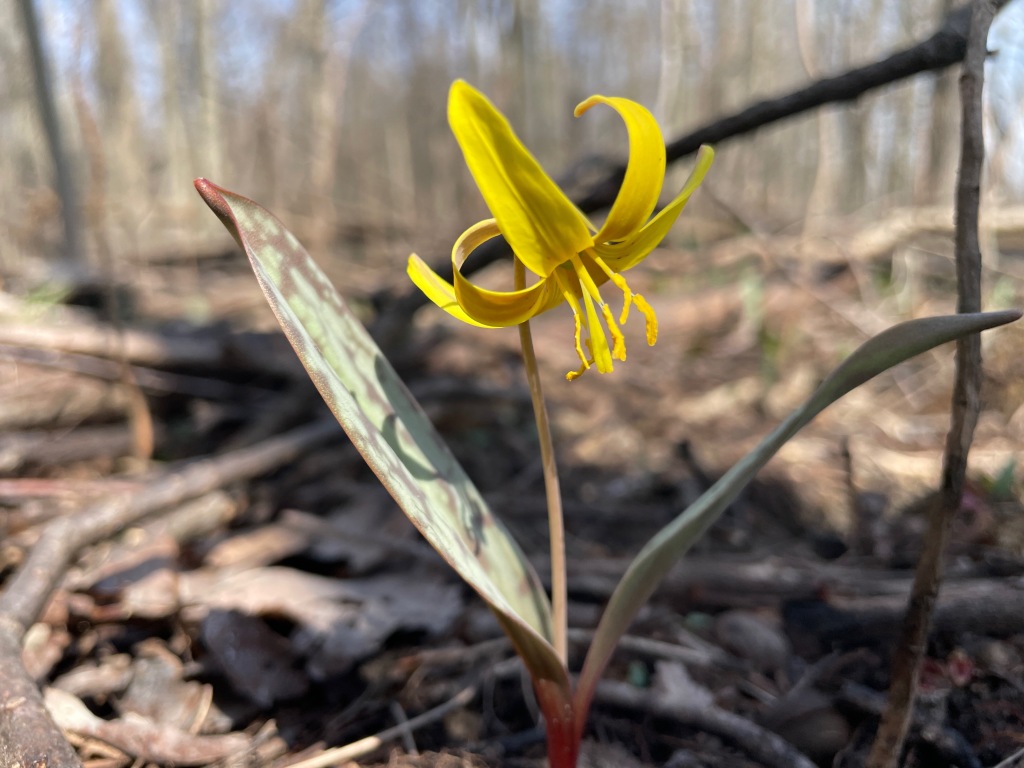
I haven’t seen a Yellow Trout Lily this year, but in mid-April last year, I was with our Natural Areas Stewardship Manager, Dr. Ben VanderWeide, when he took a photo of this one. I saw one years ago at Bear Creek Nature Park and I’ve seen the spotted leaves without the flower in many parks. Various sources say that Trout Lilies take several years to produce a bloom. And Wikipedia claims that only 10% of the plants’ pollinated flowers ever produce seed! But those few seeds do have elaiosomes for the ants. They also grow in colonies by forming buds asexually from underground corms, a kind of vertical tuber. All of which might explain why I see the leaves of this unusual plant poking out of the forest floor much more often than I do the flowers! So when I do see the actual bright yellow lily, it’s a great treat.
Cutleaf Toothwort (Cardamine concatenata)
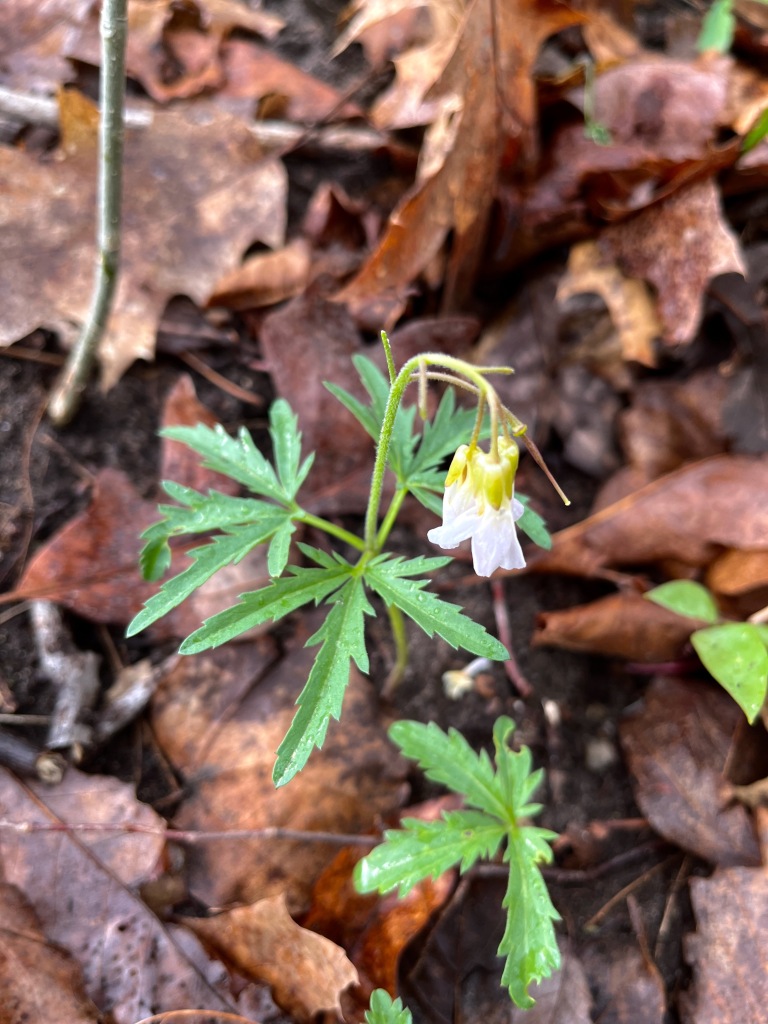
Here’s an ephemeral from Stony Creek Ravine Park that Ben showed us during a weekly birding walk – a new ephemeral for me! What you see in the photo is the fertile shoot of the plant – a stem with a whorl of three leaves below and the flowers above. According to Illinois Wildflowers, one of my favorite wildflower websites, “the basal leaves are separate from these fertile shoots; they help to store energy for next year’s fertile shoots.” And both come from the same root system – a division-of-labor arrangement that I’d only heard of before with Sensitive Fern (Onoclea sensibilis). The Illinois site also says that the presence of Cutleaf Toothwort is indicative of land that has never been plowed, and that this ephemeral tends to disappear after highly invasive Garlic Mustard (Alliaria petiolata) moves into its habitat. (See our volunteer work day schedule under Events above. For Garlic Mustard workdays, we pull as much of this invasive plant as we can in a given park!)
Early Buttercup (Ranunculus fascicularis)
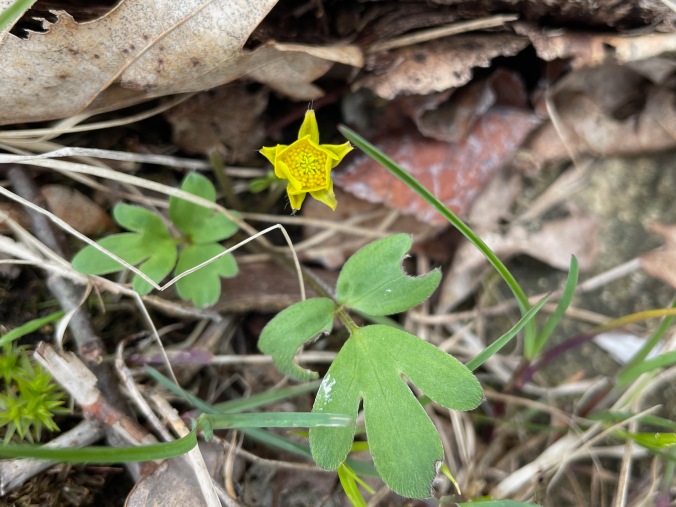
One last minute addition! While working near the Wet Prairie this week, Ben found another ephemeral that’s new to me – the Early Buttercup. It blooms in mid-spring and lasts about 2-3 weeks. The five petals are surrounded by a ring of stamens (male) with a dense cluster of pistils (female) in the center. They appear in rocky, sandy, dry soil; the Illinois Wildflower website even recommends them for rock gardens. The earliest of buttercups, they attract a variety of bees and the hoverflies (g. Syrphidae) who evolved to look like bees but have two wings instead of four. I’ll be looking in other parks for these yellow stars in woodlands with sparse leaf litter.
Other Spring Flowers
Let me share a few spring flowers that either will bloom in May or ones that are already in bloom but whose blooms may last longer – just in case the changeable weather thwarts your attempts to see the ephemerals!
Mayapples (Podophyllum peltatum)
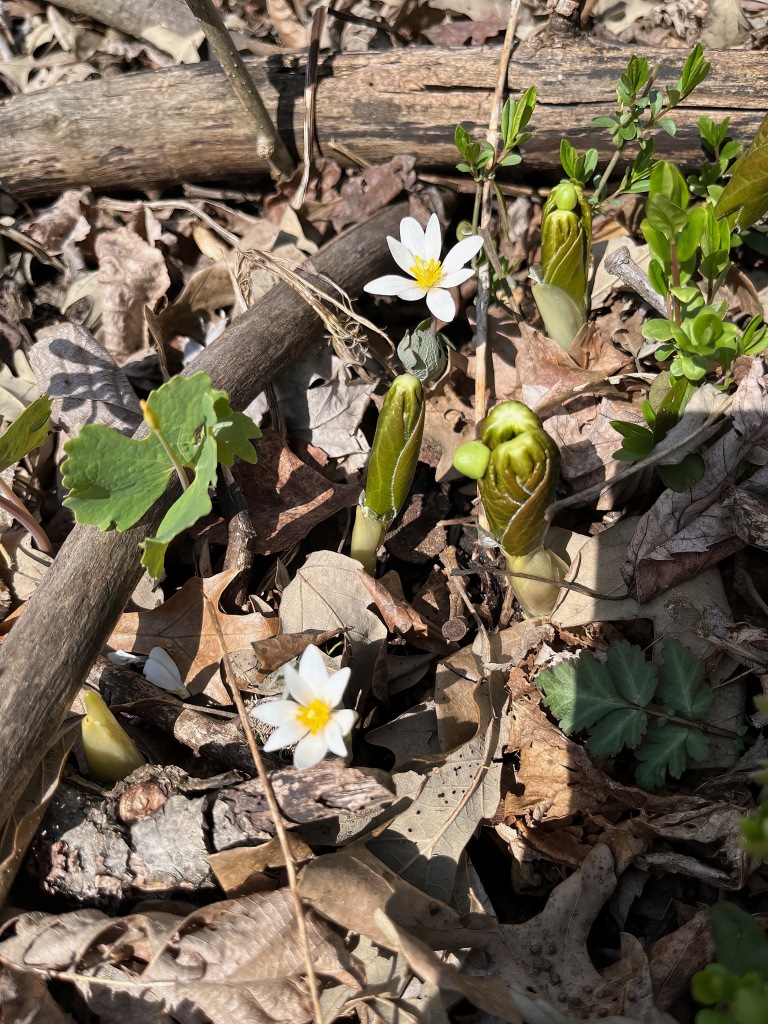
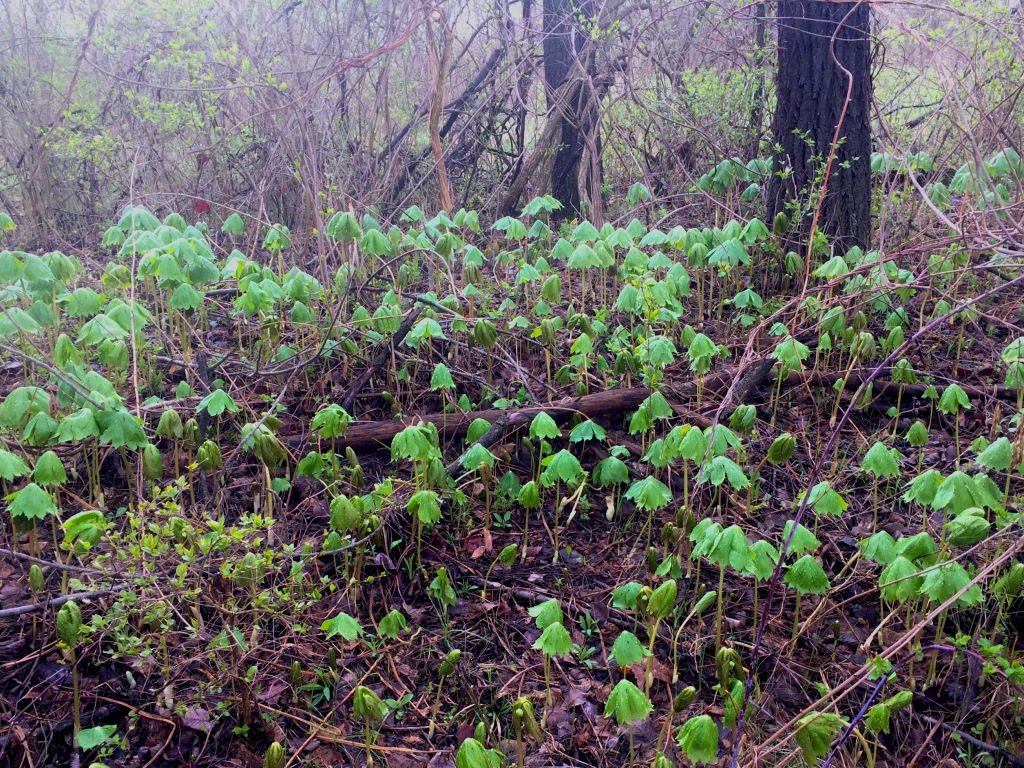
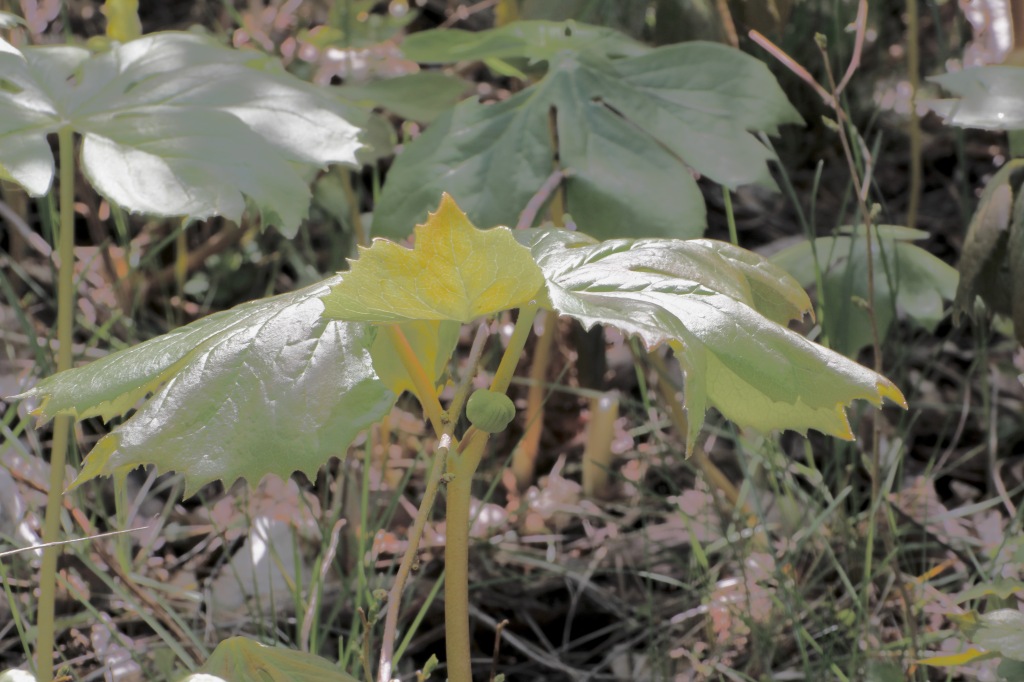


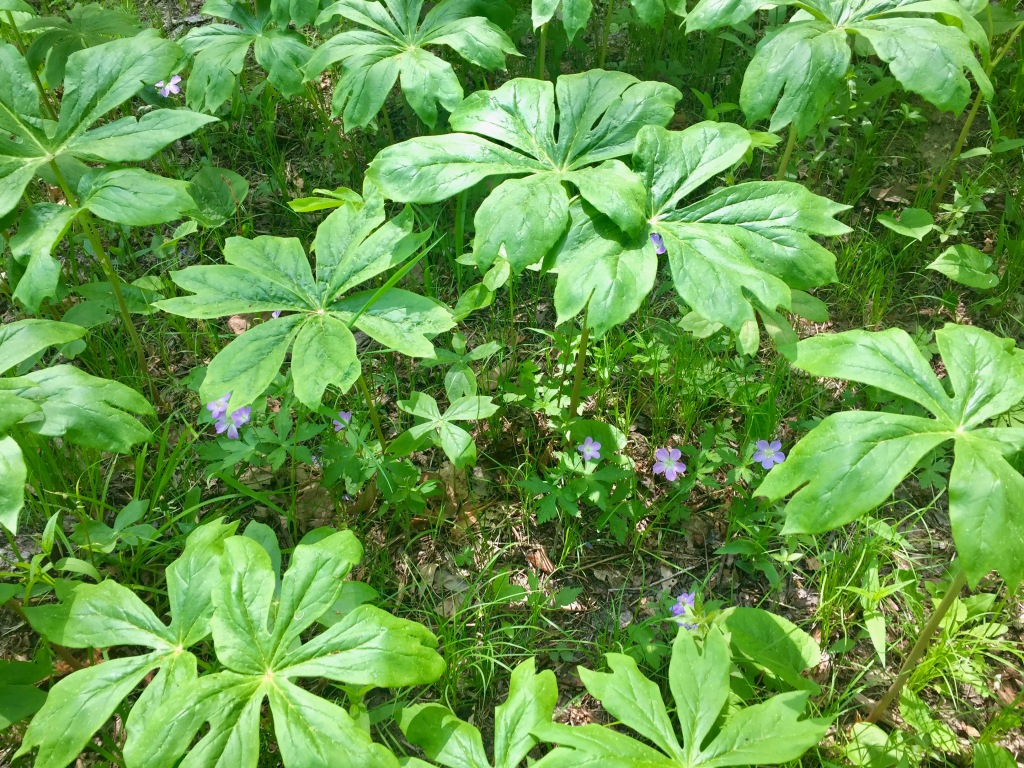
Mayapples rise from the cool earth rolled up tightly like our ubiquitous folding umbrellas. But by now their “umbrellas” are opening on the forest floor in virtually every township park. Mayapples produce colonies by spreading rhizomes, so you’ll often see groups of mayapple umbrellas scattered across the forest floor.
By mid to late-May, mayaples develop a round green bud dangling beneath their spreading mini-canopy of leaves. Soon after the buds open and a shy white flower blooms under the leaves. The flower buds and the green “apple” fruit are toxic. Toward late summer the fruit turns soft and yellow. The ripe fruit is still a bit toxic but is described as bland and edible. I haven’t tried the fruit. I’m a bit shy about trying wild foods from potentially toxic plants, for some reason…
Wild Geranium (Geranium maculatum)
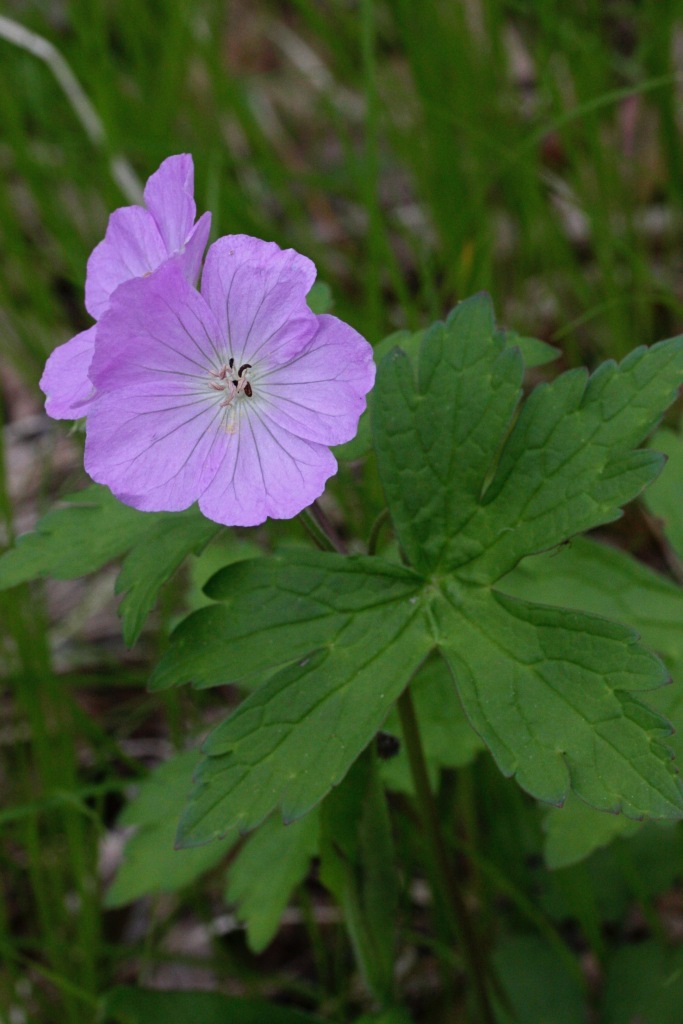

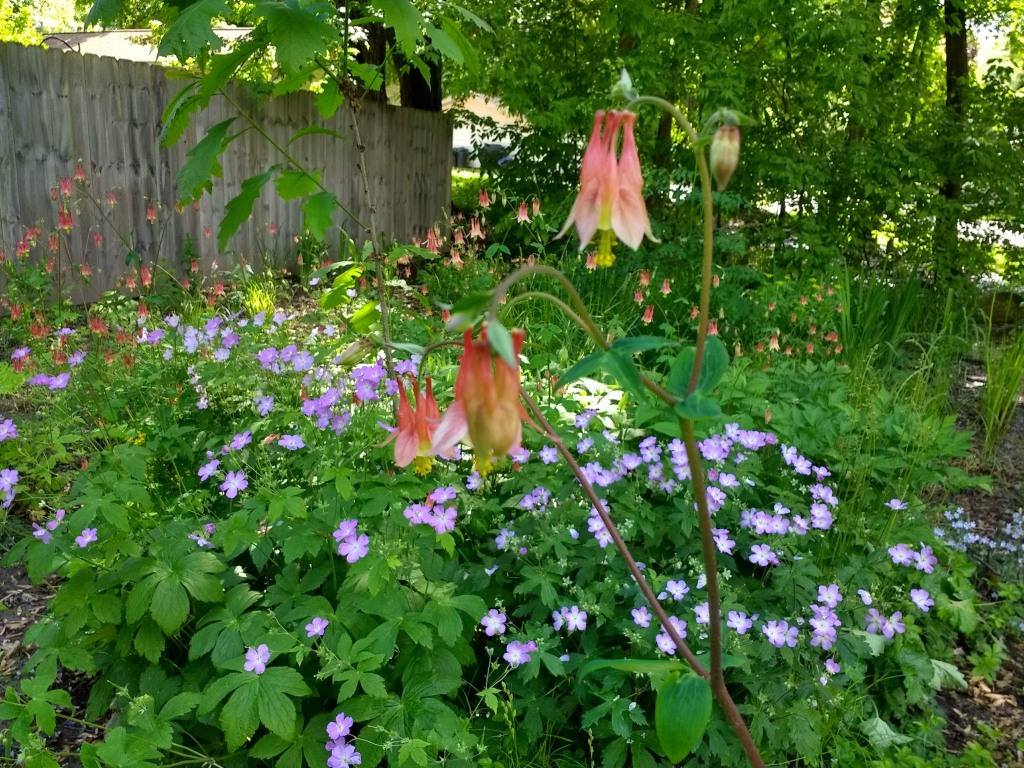
The leaves of the Wild Geranium are already up and the lavender flowers will appear soon. These simple, little geraniums (so different from the cultivated ones!) blanket the forest at Bear Creek Nature Park in May and peek out here and there all over the township. Wild Geraniums can act as a ground cover since they spread slowly by underground rhizomes and establish readily from seed in the right conditions. Their flower petals feature fine veins across the surface that guide bees and other pollinators to the nectar and pollen. Each of the five carpels in the pistil eventually elongates into a pointed fruit which protects the seeds developing inside. According to Illinois Wildflowers, at maturity each carpel curls ” upward and backward to fling the seed from the mother plant.” Imagine that! Another dramatic way to spread seed!
Marsh Marigolds (Caltha palustris)

The early spring glory of Marsh Marigolds shines forth in the mottled sunlight of early spring right now and for about a month – and then by early summer, it will completely disappear underground, living in its roots until next year. Near the Paint Creek Heritage Area – Wet Prairie on the Paint Creek Trail, where Paint Creek once flowed through a woodland, Marsh Marigolds have transformed the ancient, muddy bed into a stream of gold meandering through the woods. My photo doesn’t do it justice; it’s a sight to lift the heart, for sure! (See the explanation of when and how Paint Creek was moved to its current location in an earlier blog.).

Each marsh marigold flower can produce up to 200 seeds! The follicle that holds them splits open, forming what’s called a “splash cup.” When a raindrop hits the cup wall at just the right angle, the seeds fly out. When there’s water beneath, which there often is, a spongy substance on the seed will keep it afloat until it reaches another location. Even still water rippled by wind turns out to be an effective way to disperse seed!
Robin’s Plantain (Erigeron pulchellus)
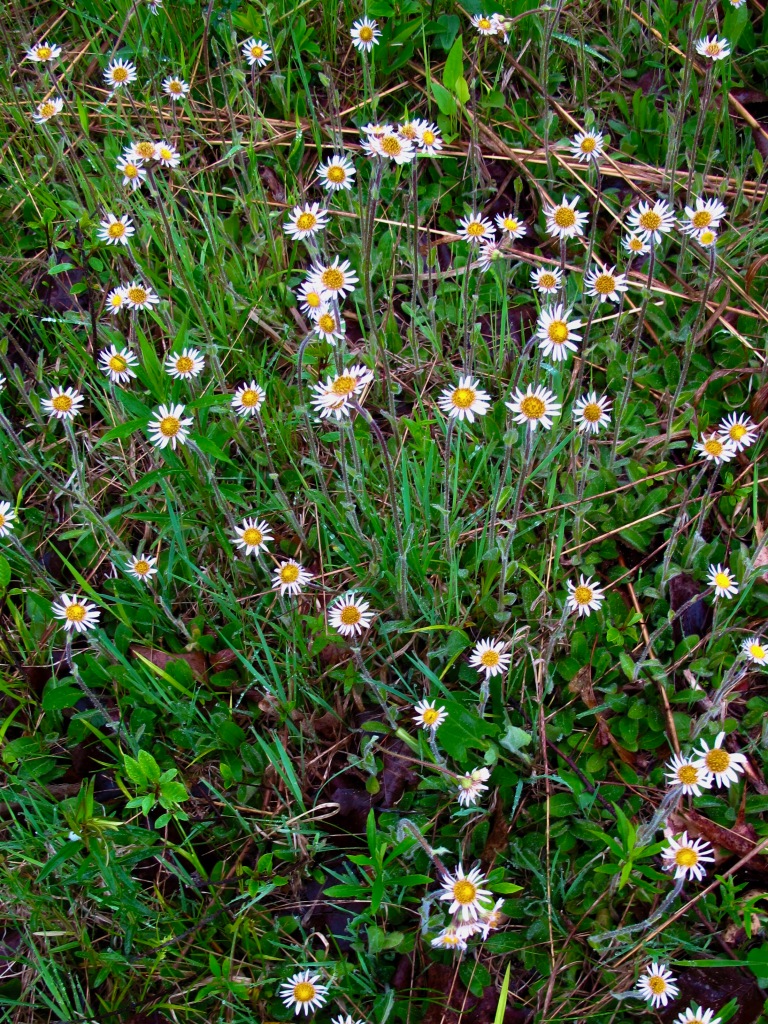
I saw these cheerful, daisy-like flowers for the first time at the Wet Prairie on the Paint Creek Trail. They start blooming around mid-May for 2-3 weeks, and may flower again later in the season if conditions are just right. They function as bright little suns in the landscape, larger than the more common blossoms of Daisy Fleabane (Erigeron annuus), but smaller than non-native daisies. They send their single seeds flying off on the breeze encased in an achene fitted out with a tuft of white hairs called pappus, much like native milkweeds do. Little butterflies, bees and other pollinators appreciate the nectar of these small spots of sunshine in the landscape.
And Last, But Maybe Not Least, Skunk Cabbage (Symplocarpus foetidus)

OK, one more plant that lasts too long to really be ephemeral. Humor me, would you? Right now, some areas of the forest floor near the Wet Prairie is carpeted with the leaves of the wonderfully strange Eastern Skunk Cabbage. The flowers of this odd and notoriously odiferous native plant emerged from the cold soil back in February and March. The plant’s hood-like spathe (left below) breaks down the starch in its roots to generate a temperature about 20 degrees warmer than the air around it! In fact, the spathe can melt ice when it needs to emerge in frigid weather! It also provides enough heat for the fertile spadix inside to develop tiny, yellow flowers on its surface.


bloom on the spadix.
Photo by Nate Martineau CC BY-NC
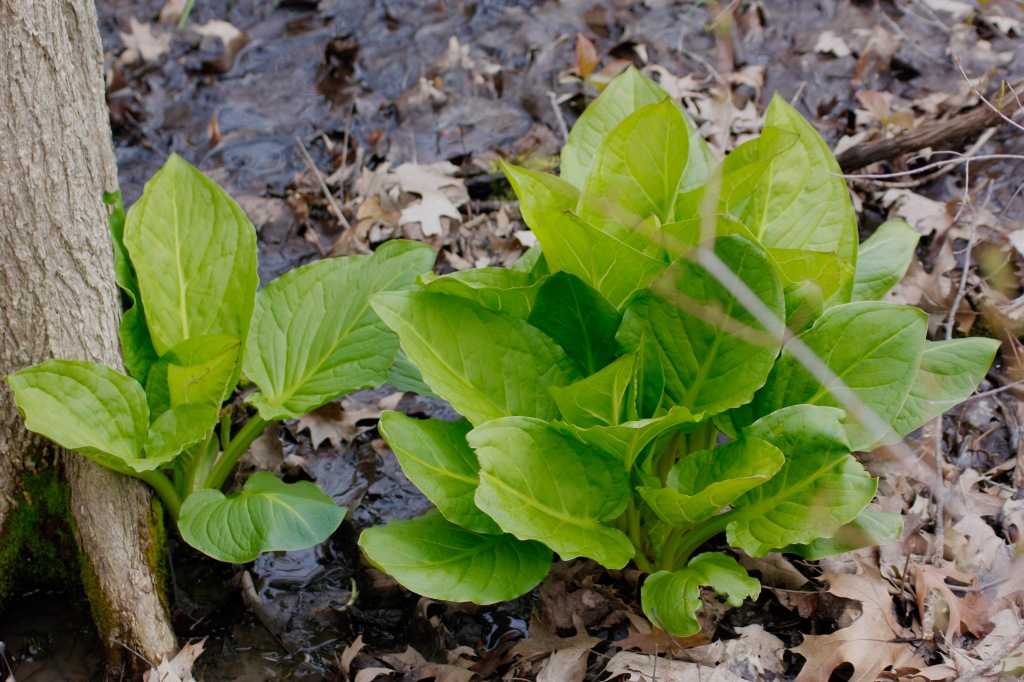
And when those tiny flowers waft their scent through the air, hold your nose if you get in close for a sniff! It’s a smell that only a carrion-eater could love! As carrion-seeking insects fly in and out, they pollinate the tiny yellow flowers on the surface of the spadix. As spring moves on, the spathe and spadix shrivel, the odor subsides and the green leaves remain for a few months to soak up the summer sunshine. Once pollinated, skunk cabbage’s fruits can form and later fall onto the forest floor to germinate nearby or be cheerfully consumed by birds and other creatures. I wonder if the fruits smell bad too? I get a kick out of that spathe and its spadix! They look like they traveled here from some distant planet … or a bad sci-fi movie.
Claiming Our Inheritance

Isn’t it amazing how nature has been infinitely inventive in seeing that our earth is both fed and beautified by plants? Flowering plants first appeared on our planet about 140-250 million years ago and like their non-flowering ancestors, they “breathe” by exchanging gasses with the atmosphere. As they do, they take in and store carbon in every part of the plant and breathe out the left-over oxygen we need to survive.
But oh, the flowering plants! What an addition to the sheer beauty of the world! The riot of colors, shapes and sizes of flowering plants grace our fields and forests. Along the way, nature discovered a plethora of ways to disperse the precious seeds that keep evolution churning out endless variations in design and new solutions for survival.
We are the lucky inheritors of millions of years of that brilliant, astonishing process called evolution. Here in Michigan, nature provides pink, white, blue and yellow blooms for our color-starved winter eyes long before we can plant our gardens in mid-May. So claim your inheritance! The ephemerals and the spring flowers that arrive after them beckon, but they won’t be around long! I truly hope you make time to see some.
